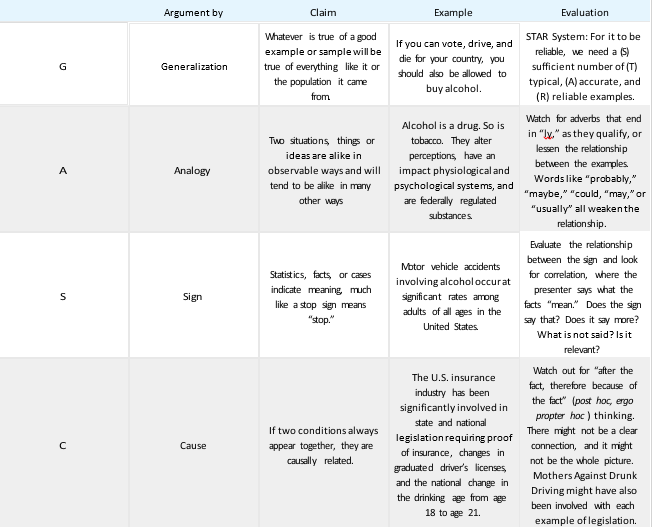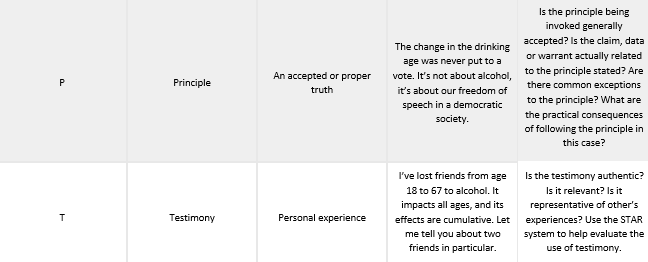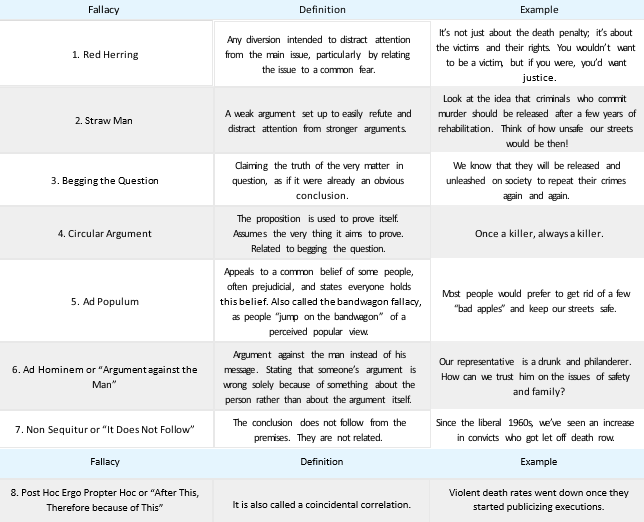Learning Objectives
Demonstrate how to form a clear argument with appropriate support to persuade your audience.
Recognize and understand inherent weaknesses in fallacies.
According to the famous satirist Jonathan Swift, “Argument is the worst sort of conversation.” You may be inclined to agree. When people argue, they are engaged in conflict and it’s usually not pretty. It sometimes appears that way because people resort to fallacious arguments or false statements, or they simply do not treat each other with respect. They get defensive, try to prove their own points, and fail to listen to each other.
But this should not be what happens in written argument. Instead, when you make an argument in your writing, you will want to present your position with logical points, supporting each point with appropriate sources. You will want to give your audience every reason to perceive you as ethical and trustworthy. Your audience will expect you to treat them with respect, and to present your argument in a way that does not make them defensive. Contribute to your credibility by building sound arguments and using strategic arguments with skill and planning.
In this section, we will briefly discuss the classic form of an argument, a more modern interpretation, and finally, seven basic arguments you may choose to use. Imagine that these are tools in your toolbox and that you want to know how each is effectively used. Know that the people who try to persuade you—from telemarketers to politicians—usually have these tools at hand.
Let’s start with a classical rhetorical strategy. It asks the rhetorician, speaker, or author to frame arguments in the following steps:

This is a standard pattern in rhetoric, and you will probably see it in both speech and English courses. The pattern is useful to guide you in preparing your document and can serve as a valuable checklist to insure you are prepared. While this formal pattern has distinct advantages, you may not see it used exactly as indicated here on a daily basis. What may be more familiar to you is Stephen Toulmin’s rhetorical strategy, which focuses on three main elements (Table 6.3.2).

Toulmin’s rhetorical strategy is useful because it makes the claim explicit, clearly illustrates the relationship between the claim and the data, and allows the reader to follow the writer’s reasoning (Toulmin, 1958). You may have a good idea or point, but your audience will want to know how you arrived at that claim or viewpoint. The warrant addresses the inherent and often unsaid question, “Why is this data so important to your topic?” In so doing, it helps you to illustrate relationships between information for your audience.
Effective Argumentation Strategies: GASCAP/T
Here is a useful way of organizing and remembering seven key argumentative strategies:
- Argument by Generalization
- Argument by Analogy
- Argument by Sign
- Argument by Consequence
- Argument by Authority
- Argument by Principle
- Argument by Testimony
Richard Fulkerson notes that a single strategy is sufficient to make an argument sometimes, but it is often better to combine several strategies to make an effective argument (Fulkerson, 1996). He organized the argumentative strategies in this way to compare the differences, highlight the similarities, and allow for their discussion. This model, often called by its acronym GASCAP, is a useful strategy to summarize six key arguments and is easy to remember. Here, we have adapted it, adding one argument that is often used in today’s speeches and presentations: the argument by testimony. Table 6.3.3 presents each argument, provides a definition of the strategy and an example, and examines ways to evaluate each approach.



Evidence
Now that we’ve clearly outlined several argument strategies, how do you support your position with evidence or warrants? If your premise or the background from which you start is valid, and your claim is clear and clearly related, the audience will naturally turn their attention to “prove it.” This is where the relevance of evidence becomes particularly important. Here are three guidelines to consider in order to ensure your evidence passes the “so what?” test of relevance in relation to your claim. Make sure your evidence has the following traits:
- Supportive. Examples are clearly representative, statistics are accurate, testimony is authoritative, and information is reliable.
- Relevant. Examples clearly relate to the claim or topic, and you are not comparing “apples to oranges.”
- Effective. Examples are clearly the best available to support the claim; quality is preferred to quantity, and there are only a few well-chosen statistics, facts, or data.
Appealing to Emotions
While we’ve highlighted several points to consider when selecting information to support your claim, know that Aristotle strongly preferred an argument based in logic over emotion. Can the same be said for your audience, and to what degree is emotion and your appeal to it in your audience a part of modern life?
Emotions are psychological and physical reactions, such as fear or anger, to stimuli that we experience as feelings. Our feelings or emotions directly impact our own point of view and readiness to communicate, but they also influence how, why, and when we say things. Emotions influence not only how you say or what you say but also how you hear or what you hear. At times, emotions can be challenging to control. Emotions will move your audience, and possibly even move you, to change or act in certain ways.
Aristotle thought the best and most preferable way to persuade an audience was through logic, free of emotion. He also recognized that people are often motivated, even manipulated, by the exploitation of their emotions. In a business context, we still engage in this debate, demanding to know the facts separate from personal opinion or agenda, but we also see the use of emotional appeal to sell products.
Marketing experts are famous for creating a need or associating an emotion with a brand or label to sell it. In your document, you will speak the language of your audience and may choose to appeal to emotion. However, you need to consider how the strategy works, as it may be considered a tool with two edges.
If we think of the appeal to emotion as a knife, we can see it has two edges. One edge can cut your audience, and the other can cut you. If you advance an appeal to emotion in your document on spaying and neutering pets and discuss the millions of unwanted pets that are killed each year, you may elicit an emotional response. If you use this approach repeatedly, your audience may grow weary of it, and it will lose effectiveness. If you change your topic to the use of animals in research, the same strategy may apply, but repeated attempts to elicit an emotional response may backfire (i.e., in essence, “cutting” you) and produce a negative response called “emotional resistance.”
Emotional resistance involves getting tired, often to the point of rejection, of hearing messages that attempt to elicit an emotional response. Emotional appeals can wear out the audience’s capacity to receive the message. As Aristotle outlined, ethos (credibility), logos (logic), and pathos (passion, enthusiasm, and emotional response) constitute the building blocks of any document. It’s up to you to create a balanced document, where you may appeal to emotion but choose to use it judiciously.
On a related point, the use of an emotional appeal may also impair your ability to write persuasively or effectively. For example, if you choose to present an article about suicide to persuade people against committing it and you start showing a photo of your brother or sister that you lost to suicide, your emotional response may cloud your judgment and get in the way of your thinking. Never use a personal story, or even a story of someone you do not know if the inclusion of that story causes you to lose control. While it’s important to discuss relevant topics, you need to assess your relationship to the message. Your documents should not be an exercise in therapy. Otherwise, you will sacrifice ethos and credibility, even your effectiveness, if you “lose it” because you are really not ready to discuss the issue.
Recognizing Fallacies
“Fallacy” is another way of saying false logic. Fallacies or rhetorical tricks deceive your audience with their style, drama, or pattern but add little to your document in terms of substance. They are best avoided because they can actually detract from your effectiveness. Several techniques or “tricks” allow the writer to rely on style without offering substantive argument, to obscure the central message, or to twist the facts for their own gain. Table 6.3.4 examines the eight classical fallacies. Learn to recognize them so they can’t be used against you, and learn to avoid using them with your audience.

Ethical Considerations in Persuasion
Richard Johannesen offers eleven points to consider when communicating in his book Ethics in Human Communication. Although they are related to public speaking, they are also useful in business writing. You may note that many of his cautions are clearly related to the fallacies we’ve discussed. His main points reiterate many of the points across this chapter and should be kept in mind as you prepare and present your persuasive message (Johannesen, 1996).
Do not use false, fabricated, misrepresented, distorted, or irrelevant evidence to support arguments or claims; intentionally use unsupported, misleading, or illogical reasoning; represent yourself as informed or an “expert” on a subject when you are not; use irrelevant appeals to divert attention from the issue at hand; ask your audience to link your idea or proposal to emotion-laden values, motives, or goals to which it is actually not related; deceive your audience by concealing your real purpose, your self-interest, the group you represent, or your position as an advocate of a viewpoint; distort, hide, or misrepresent the number, scope, intensity, or undesirable features of consequences or effects; use emotional appeals that lack a supporting basis of evidence or reasoning; oversimplify complex, gradation-laden situations into simplistic, two-valued, either-or, polar views or choices; pretend certainty where tentativeness and degrees of probability would be more accurate; advocate something that you yourself do not believe in.
Aristotle said the mark of a good, well-spoken person was a clear command of the faculty of observing, in any given case, the available means of persuasion. He discussed the idea of perceiving the various points of view related to a topic and their thoughtful consideration. While it’s important to perceive a case’s complexity, you are not asked to be a lawyer and defend a client.
In your message to persuade, consider honesty and integrity as you assemble your arguments. Your audience will appreciate your thoughtful consideration of more than one view and your understanding of the issue’s complexity, thus building your ethos or credibility as you present your document. Be careful not to stretch the facts or assemble them only to prove your point; instead, prove the argument on its own merits. Deception, coercion, intentional bias, manipulation, and bribery should have no place in your message to persuade.
Key Takeaway
The art of argument in writing involves presenting supportive, relevant, and effective evidence for each point and doing it in a respectful and ethical manner.
Exercises
Select a piece of persuasive writing, such as a newspaper op-ed essay, a magazine article, or a blog post. Examine the argument, the main points, and how the writer supports them. Which strategies from the foregoing section does the writer use? Does the writer use any fallacies or violate any ethical principles? Discuss your results with your classmates.
Find one slogan or logo that you perceive as persuasive and share it with your classmates.
Find an example of a piece of writing that appears to want to be persuasive but doesn’t get the job done. Write a brief review and share it with classmates.
In what ways might the choice of how to organize a document involve ethics? Explain your response and discuss it with your class.
Fulkerson, R. (1996). The Toulmin model of argument and the teaching of composition. In E. Barbara, P. Resch, & D. Tenney (Eds.), Argument revisited: argument redefined: negotiating meaning the composition classroom (pp. 45–72). Thousand Oaks, CA: Sage.
Johannesen, R. (1996). Ethics in human communication (4th ed.). Prospect Heights, IL: Waveland Press.
Toulmin, S. (1958). The uses of argument. New York, NY: Cambridge University Press.
This page titled 6.3: Making an Argument is shared under a CC BY-NC-SA 3.0 license and was authored, remixed, and/or curated by Anonymous (LibreTexts Staff), from which source content was edited to the style and standards of the Pressbook platform licensed under a Creative Commons Attribution-NonCommercial-ShareAlike 4.0 International License by Brandi Schur.

